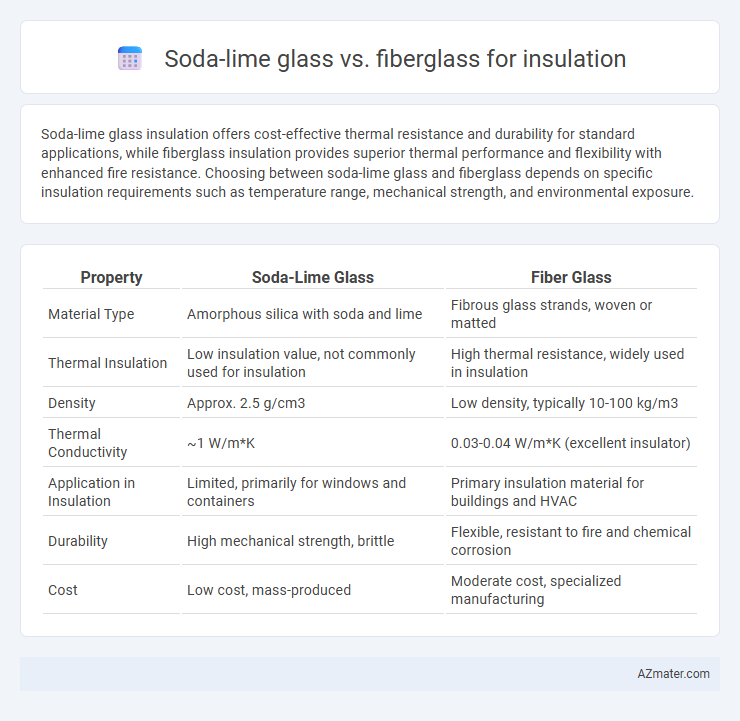Soda-lime glass insulation offers cost-effective thermal resistance and durability for standard applications, while fiberglass insulation provides superior thermal performance and flexibility with enhanced fire resistance. Choosing between soda-lime glass and fiberglass depends on specific insulation requirements such as temperature range, mechanical strength, and environmental exposure.
Table of Comparison
| Property | Soda-Lime Glass | Fiber Glass |
|---|---|---|
| Material Type | Amorphous silica with soda and lime | Fibrous glass strands, woven or matted |
| Thermal Insulation | Low insulation value, not commonly used for insulation | High thermal resistance, widely used in insulation |
| Density | Approx. 2.5 g/cm3 | Low density, typically 10-100 kg/m3 |
| Thermal Conductivity | ~1 W/m*K | 0.03-0.04 W/m*K (excellent insulator) |
| Application in Insulation | Limited, primarily for windows and containers | Primary insulation material for buildings and HVAC |
| Durability | High mechanical strength, brittle | Flexible, resistant to fire and chemical corrosion |
| Cost | Low cost, mass-produced | Moderate cost, specialized manufacturing |
Introduction to Glass Types for Insulation
Soda-lime glass, commonly used in window panes and containers, is a versatile material with moderate thermal insulation properties but limited resistance to high temperatures. Fiber glass, made from fine strands of glass fibers, excels in thermal insulation due to its low thermal conductivity and ability to trap air within its structure. Its widespread use in building insulation and HVAC systems highlights superiority in energy efficiency compared to traditional soda-lime glass.
Composition of Soda-Lime Glass
Soda-lime glass, primarily composed of approximately 70-74% silica (SiO2), 12-16% sodium oxide (Na2O), and 5-10% calcium oxide (CaO), offers a rigid and transparent structure commonly used in windows and containers, whereas fiberglass insulation consists of fine glass fibers made mainly from silica sand, limestone, and soda ash. The high silica content in soda-lime glass grants durability and chemical resistance but limits its thermal insulation properties compared to fiberglass, which provides superior thermal and acoustic insulation due to its fibrous, porous composition. Understanding the compositional differences highlights why fiberglass is preferred for insulation applications, while soda-lime glass is favored for structural and aesthetic uses.
Composition of Fiber Glass
Fiber glass insulation consists primarily of fine glass fibers made from silica sand, soda ash, limestone, and recycled glass, combined with binders to enhance durability and flexibility. In contrast, soda-lime glass, the most common glass type, is composed mainly of about 70-74% silica, 12-16% soda ash, and 5-12% lime, resulting in a denser, solid structure unsuitable for insulation purposes. The fibrous, porous nature of fiber glass allows it to trap air effectively, providing superior thermal and acoustic insulation compared to the rigid, non-porous soda-lime glass.
Manufacturing Processes Compared
Soda-lime glass insulation is produced by melting silica sand with soda ash and limestone at high temperatures, followed by controlled cooling to form a rigid glass sheet or container. Fiber glass insulation manufacturing involves melting the same raw materials into molten glass, then drawing it into fine fibers using spinning or blowing techniques before binding with a resin binder to create flexible mats or batts. The key difference lies in the fiber glass's extensive fiber formation and binding process, which enhances thermal insulation, whereas soda-lime glass is primarily a solid, non-fibrous material with lower insulating properties.
Thermal Insulation Properties
Fiber glass exhibits superior thermal insulation properties compared to soda-lime glass due to its low thermal conductivity, typically around 0.04 W/m*K, which effectively reduces heat transfer. Soda-lime glass, with a thermal conductivity near 1.1 W/m*K, is less effective as an insulator and primarily serves structural and transparent applications. The porous, fibrous structure of fiber glass traps air, enhancing its insulating performance in building and industrial insulation systems.
Mechanical Strength and Durability
Soda-lime glass offers moderate mechanical strength but is more prone to cracking under stress compared to fiberglass, which boasts higher tensile strength and flexibility due to its woven fiber composition. Fiberglass insulation demonstrates superior durability, resisting moisture, chemicals, and thermal cycling, whereas soda-lime glass may degrade faster in harsh environmental conditions. The enhanced mechanical resilience and longevity of fiberglass make it the preferred choice for insulation applications requiring robust structural integrity.
Moisture and Chemical Resistance
Fiber glass insulation offers superior moisture resistance compared to soda-lime glass, reducing the risk of water absorption that can compromise insulating performance. Chemically, fiber glass is more resistant to alkalis and acids, maintaining structural integrity in harsh environments, whereas soda-lime glass is more susceptible to chemical degradation. These properties make fiber glass a more durable and reliable choice for insulation in moisture-prone and chemically aggressive conditions.
Environmental Impact and Sustainability
Soda-lime glass, primarily composed of silica, soda ash, and limestone, offers a more environmentally sustainable option due to its high recyclability and lower energy consumption during production compared to fiberglass. Fiberglass insulation, while effective for thermal resistance, relies heavily on synthetic materials and energy-intensive manufacturing processes, leading to greater carbon emissions and less environmentally friendly disposal options. Evaluating the environmental impact, soda-lime glass insulation supports a circular economy by enabling material recovery and reducing landfill waste, enhancing sustainability in insulation applications.
Cost and Availability
Soda-lime glass is widely available and generally less expensive than fiberglass, making it a cost-effective option for insulation in residential and commercial applications. Fiberglass insulation, while slightly more costly, offers better thermal performance and durability, often justifying the higher upfront investment. Availability of soda-lime glass is higher due to its common use in windows and containers, whereas fiberglass production is more specialized for insulation materials.
Choosing the Right Glass for Insulation Needs
Soda-lime glass offers cost-effective insulation with moderate thermal resistance, making it suitable for general-purpose applications where budget constraints exist. Fiber glass insulation provides superior thermal performance and excellent sound absorption, ideal for environments requiring enhanced energy efficiency and noise reduction. Selecting the right glass depends on specific insulation requirements, thermal conductivity values, and budget considerations to maximize energy savings and comfort.

Infographic: Soda-lime glass vs Fiber glass for Insulation
 azmater.com
azmater.com